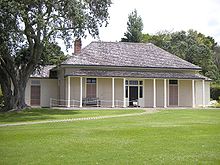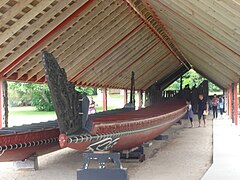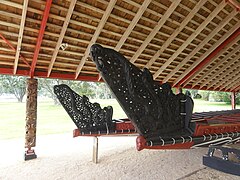Treaty House
The Treaty House is a building in Waitangi on the North Island of New Zealand . It was the home of the British resident in New Zealand, James Busby . In 1835, New Zealand's declaration of independence , which established New Zealand as an independent colony, was signed here. It is better known for the Waitangi Treaty signed on February 6, 1840 on the site .
The house and land remained private until 1932, when Governor General Viscount Bledisloe bought it and donated it to the nation. In 1934 they were made a National Reserve in a ceremony attended by thousands of people . Among the visitors were Māori , including the Māori king and Pākehā . Another major event took place in 1940 on the 100th anniversary of the treaty. Waitangi Day celebrations have been held annually on the site since 1947 .
history
The Treaty House was built for Busby and his family in 1833/34 . The design comes from the Australian architect John Verge . Since the estimated construction costs of almost £ 600 seemed too high, the colonial architect Ambrose Hallen painted the back of the building, reducing the cost to an estimated £ 278. In addition to kauri slats and shingles purchased locally , hardwood from New South Wales , Australia , was used where it was prefabricated. The material was shipped to Paihia on the schooner New Zealander and brought from Māori in canoes to Waitangi . There the structure was built by European workers, which, according to pay slips, took at least 566 days.
It is one of the oldest surviving buildings in New Zealand. It originally consisted of two main rooms, a corridor, a veranda and a separate outbuilding with a kitchen and rooms for the staff. Busby saw the house as too small for its status, but it was a big house for 1830s New Zealand. In the 1830s and 1840s it was expanded with an annex to the rear and two wings in the courtyard.
Busby died in 1871. In 1882 the Busby family sold the property to a farmer. For at least a few years it was used for agricultural purposes, such as sheep shearing and as a storage room for hay. It deteriorated increasingly. Around 1900 it was prepared for residential use, the north wing torn down and the veranda rebuilt. In 1932, the then New Zealand governor Bledisloe bought the site and gave it the current name " Treaty House ". The house was restored under the architect WH Gummer . This was one of the first major state restorations of a historic building in New Zealand. The north wing was rebuilt, the south wing was replaced by exhibition rooms. In preparation for the 150th anniversary of the signing of the contract in 1990, the house was adapted more to the condition in 1840.
The house has been listed as Historic Place Category I by the New Zealand Historic Places Trust since June 23, 1983 . It was the sixth monument to be registered in New Zealand. It is now a museum dedicated to the Waitangi Treaty and mid-19th century home life. On the site there is a carved Whare Runanga (meeting house) and the large Waka Taua (war canoe) Ngā Toki Matawhaorua , both of which were built to mark the 1940 anniversary. A flagpole stands at the place where the Waintangi Treaty was signed. The original mast was erected by the New Zealand Division of the Royal Navy in 1934. The Waitangi Treaty Monument is nearby, it was built between 1880 and 1881 and is also a Category 1 monument.
Photo gallery
View from the garden towards Russell
Web links
- Homepage . Waitangi Treaty Grounds,accessed March 18, 2018.
- Waitangi Treaty Grounds . Heritage New Zealand,accessed March 18, 2018.
Individual evidence
- ↑ a b c d Information boards in the Museum of the Treaty House
- ↑ Vernon H. Reed : The Gift of Waitangi . a history of the Bledisloe gift . AH & AW Reed , Wellington 1957 (English).
- ↑ a b c Waitangi Treaty Grounds. Historic Place Category 1. In: New Zealand Heritage List / Rārangi Kōrero . Heritage New Zealand Pouhere Taonga , June 23, 1983, accessed September 25, 2019 .
- ↑ Melanie Lovell-Smith : History and Historic Places . Some Thoughts on History and Historic Places in New Zealand during the Late Nineteenth and Twentieth Centuries . University of Auckland , Auckland 2000, pp. 56 (English, master's thesis).
- ↑ Patrick McAllister : Waitangi Day . An annual enactment of the treaty? . In: Sites . Volume 4, Issue 2 , 2007, pp. 157 , doi : 10.11157 / sites-vol4iss2id78 (English, online [accessed February 24, 2013]).
- ^ Waitangi Treaty Monument. Historic Place Category 1. In: New Zealand Heritage List / Rārangi Kōrero . Heritage New Zealand Pouhere Taonga , March 19, 1987, accessed September 23, 2019 .
Coordinates: 35 ° 15 ′ 56.9 ″ S , 174 ° 4 ′ 53.8 ″ E








